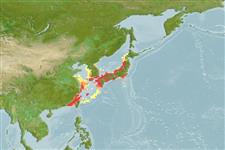分类 / Names
俗名 | 同种异名 | Catalog of Fishes(属, 种) | ITIS | CoL | WoRMS | Cloffa
Issue
All subspecies of Plecoglossus altivelis (Temminck & Schlegel, 1846) are synonymised under the species in Eschmeyer (CofF ver. Jul. 2010: Ref. 84883). Please send references, or more studies are needed.
Environment: milieu / climate zone / depth range / distribution range
生态学
海洋; 淡水; 半咸淡水 居于水底的; 非产卵性溯降河的 (Ref. 51243); 深度上下限 10 - ? m. 亚热带的; 44°N - 23°N
Northwest Pacific: western Hokkaido in Japan southward to the Korean Peninsula, Taiwan and China.
西北太平洋: 在日本向南至朝鲜半岛,台湾与中国的北海道西部。 一个亚种 琉球香鱼〔Plecoglossus altivelis ryukyuensis〕 出现于 Nansei 中-shoto ,日本.(参考文献 34989)
Length at first maturity / 大小 / 重量 / 年龄
Maturity: Lm 27.5, range 30 - 40 cm
Max length : 70.0 cm TL 雄鱼/尚未辨别雌雄; (Ref. 12218); common length : 15.0 cm SL 雄鱼/尚未辨别雌雄; (Ref. 35840); 最大年龄: 3.00 年 (Ref. 12218)
背棘 (总数) : 0; 背的软条 (总数) : 10 - 11; 臀鳍软条: 14 - 15; 脊椎骨: 60 - 63. Pyloric caeca 350-400.
幽门盲囊 350-400.
Typical amphidromous fish; appears in near shore from late autumn to spring (Ref. 11230). Found in lakes and rivers, preferring clean river water and can be found the entire river long, from the head to the mouth (Ref. 12218). Ascends the river during March when the temperature is around 10°C (Ref. 12218). Adults spawn in the spring, in the lower reaches of rivers. After spawning, some adults die while others return to the sea. Larvae enter the sea immediately after hatching and remain there during winter, feeding on plankton. In springtime, the young (5-7 cm TL) move upstream to the middle reaches of rivers to feed on algae. Fish (about 6-9 cm) start schooling at the river mouth and are insectivores and eat algae
off small pebbles (Ref. 12218); this is assisted by small leaf-like teeth which are loosely attached to the jaw with two ligaments (Ref. 45181). Those that are ready to spawn (about 20 cm TL) move downstream to the lower reaches of the river. Spawning adults from the sea migrate upstream to the lower reaches as well. Some fish spawn two or three years in succession, others only once (Ref. 9987 & 559). River forms live usually only one year whereas lake forms can live two or three years (Ref. 12218). Reaches maturity at 30-40 cm (Ref. 12218). Highly esteemed food fish. Marketed fresh and consumed fresh, fried and broiled (Ref. 9987).
典型的河海两域洄游的鱼; 在从秋季末到春天的近岸出现。 (参考文献 11230) 发现于湖与河了, 偏爱乾净的河水而且被发现于整个的河长的, 从头部对嘴巴.(参考文献 12218) 在温度是大约 10 °C 的三月期间上溯到河。 (参考文献 12218) 成鱼产卵于春天中,在河的下面范围方面。 在产卵之后,当其它回到海洋的时候,一些成鱼死。 仔鱼在孵化之后紧邻进入海洋而且在冬天期间逗留在哪里, 吃浮游生物。 在春天, 幼鱼 (5-7 公分TL) 移动溯河到河的中游觅食藻类。 鱼 (大约 6-9 公分) 开始在河嘴群游而且是食虫动物而且吃藻类
外海的小小圆石;(参考文献 12218) 这被小叶状的齿协助松弛地那是依附于颌有两个结带.(参考文献 45181) 那些那是预备好的状态产卵 (大约 20 公分TL) 移动向下到河的下面范围。 产卵的成鱼距离海洋移动也溯河到下面的范围。 一些鱼在连续方面产卵二或三年, 其它是只有一次 (参考文献 9987&559). 然而湖表格能生活二或三年,河表格通常生活只有一年。 (参考文献 12218) 在 30-40 公分达到成熟。 (参考文献 12218) 深受喜爱的食用鱼。 在市场上销售生鲜地而且生鲜消费, 油炸了而且火烤了。 (参考文献 9987)
Life cycle and mating behavior
成熟度 | 繁殖 | 产卵场 | 卵 | 孕卵数 | 仔鱼
During spawning some fish go up the river and some fish spawn on the river shoreline above pebbles. Spawns at night and excavates a 10cm (diameter or depth?) pit. Eggs are around 1 mm in size and adhere to the sand or pebbles for 14 to 20 days before hatching. This fish is semelparous and releases eggs many times over a short period each time releasing ~10,000 eggs. Sometimes females that want to spawn but cannot, save their strength, and go to a deep stagnant pool. These females wait until spring before going up the river with young fish. After hatching, the larvae are 6 mm and flow with the water current eating plankton. Juvenile fish will come again to the river in spring. These live in schools. When schools of Plecoglossus altivelis return to their river they guard their territory and eat food (Ref. 12218).
Reproductive mode varies between semelparity and iteroparity. Large females spawn once, while smaller females spawn twice during a two-week interval (Ref. 76896).西北太平洋: 在日本向南至朝鲜半岛,台湾与中国的北海道西部。 一个亚种 琉球香鱼〔Plecoglossus altivelis ryukyuensis〕 出现于 Nansei 中-shoto ,日本.(参考文献 34989)
Masuda, H., K. Amaoka, C. Araga, T. Uyeno and T. Yoshino, 1984. The fishes of the Japanese Archipelago. Vol. 1. Tokai University Press, Tokyo, Japan. 437 p. (text). (Ref. 559)
世界自然保护联盟红皮书 (Ref. 130435: Version 2024-2)
人类利用
渔业: 高经济性; 养殖: 商业性; 游钓鱼种: 是的
工具
特别资料
下载 XML
网络资源
Estimates based on models
Preferred temperature (Ref.
123201): 13 - 22.6, mean 19.7 °C (based on 42 cells).
Phylogenetic diversity index (Ref.
82804): PD
50 = 1.5000 [Uniqueness, from 0.5 = low to 2.0 = high].
Bayesian length-weight: a=0.00427 (0.00166 - 0.01096), b=3.06 (2.83 - 3.29), in cm total length, based on LWR estimates for this (Sub)family-body shape (Ref.
93245).
营养阶层 (Ref.
69278): 2.8 ±0.16 se; based on food items.
回复力 (Ref.
120179): 高度, 族群倍增时间少于 15个月 (tm=1; tmax=3; Fec=50,000-100,000).
Fishing Vulnerability (Ref.
59153): Moderate to high vulnerability (48 of 100).
Nutrients (Ref.
124155): Calcium = 78 [36, 203] mg/100g; Iron = 1.19 [0.62, 2.98] mg/100g; Protein = 16.2 [13.8, 18.2] %; Omega3 = 0.445 [0.196, 1.234] g/100g; Selenium = 73.2 [35.2, 156.1] μg/100g; VitaminA = 4.44 [1.39, 14.45] μg/100g; Zinc = 0.804 [0.513, 1.253] mg/100g (wet weight);
